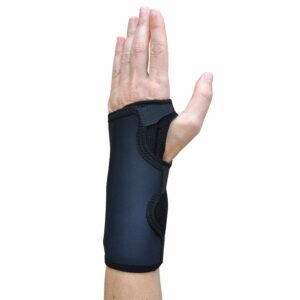Wrist Tendonitis
Updated:
(Also known as Wrist Tendinitis, Wrist Tendinopathy)
N.B. Although recent research suggests that ‘wrist tendinopathy’ is a more appropriate term to describe overuse injuries to the wrist tendons, we will use the term ‘wrist tendonitis’ in this document as it is more widely known.
What is wrist tendonitis?
Wrist tendonitis is a relatively common overuse condition which may affect one or more wrist tendons and is characterized by tissue damage, pain and often swelling of the affected tendons.
Whilst the term wrist tendonitis technically means ‘inflammation of the wrist tendons’, recent studies have demonstrated that overuse tendon injuries have little or no inflammation present and instead are primarily characterised by collagen (the protein responsible for giving tendons their tensile strength) degeneration, fiber disorientation and thinning, scattered vascular in-growth and increased molecules known as gylcosaminoglycans (responsible for attracting water and forming an important component of tendon and cartilage tissue).
The forearm comprises of two long bones known as the radius and the ulna. These bones connect with several small bones known as the carpal bones forming the wrist (figure 1). Many muscles of the wrist and hand originate from the radius and ulnar and cross the wrist to insert into the bones of the wrist, hand and fingers via the wrist tendons. These muscles fall into two broad groups known as the wrist and finger flexors (which lie on the palm side of the forearm and wrist) and the wrist and finger extensors (which lie on the opposite side of the forearm and wrist) (figure 2). Generally, the wrist and finger flexors are responsible for bending the wrist and fingers forwards (e.g. making a fist), whilst the wrist and finger extensors are responsible for straightening the wrist and fingers and bending them backwards. Collectively, the muscles are responsible for gripping activity, movement of the wrist in all directions and general activities involving use of the wrist and fingers such as lifting, holding, carrying, writing, typing and pulling activities.
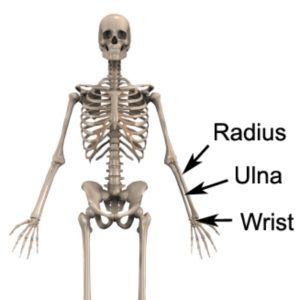
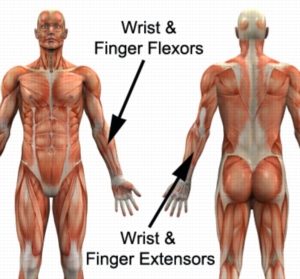
During contraction of the muscles of the wrist, tension is placed through the wrist tendons. When this tension is excessive due to too much repetition, prolonged force or high force, damage to the wrist tendons may occur. Wrist tendonitis is a condition whereby there is damage, with subsequent degeneration, fibre disorganisation / thinning and often swelling affecting one or more of the wrist tendons. This is usually due to gradual wear and tear associated with overuse, however it may also occur traumatically due to a specific incident.
Causes of wrist tendonitis
Wrist tendonitis most commonly occurs due to repetitive or prolonged activities placing strain on the wrist tendons. These activities may include sports such as gymnastics, golf or racquet sports as well as manual work such as carpentry, painting, chopping wood, bricklaying, repetitive use of a hammer or screw driver, use of vibrating machinery, gardening, sewing and knitting or working at a computer (i.e. excessive use of a mouse or typing). Wrist tendonitis may also occur from other activities involving forceful or repetitive gripping of the hand.
It is common for patients to develop this condition following a sudden increase in force, frequency or duration of activities that place stress on the wrist tendons or due to a change in these activities. Occasionally, wrist tendonitis may develop suddenly. This can be due to a fall onto an outstretched hand, a direct impact to the wrist tendons or due to a forceful movement involving heavy lifting or a gripping force through the wrist. A history of wrist, elbow, shoulder, neck or upper back injury may increase the likelihood of a patient developing this condition.
Signs and symptoms of wrist tendonitis
The symptoms associated with this condition usually develop gradually over a period of time. Initially, symptoms may present as an ache or stiffness in the wrist and hand following an aggravating or unaccustomed activity. This may often be felt at night or upon waking the following morning and may warm up with heat and movement in the early stages.
As the condition progresses, pain may be felt with every day activities involving the wrist and fingers such as carrying groceries, opening jars or doors, shaking hands or using a computer. Patients with this condition often find that they can participate in activities using the wrist tendons (such as gripping) particularly once they have warmed up, only to experience an increase in symptoms after the activity with rest (i.e. at night or upon waking the following morning). Patients with wrist tendonitis may also experience pain on firmly touching the affected wrist tendons, swelling and sometimes, crepitus (i.e. a grating sound or sensation in the tendon).
Occasionally, pins and needles or numbness in the fingers may be experienced along with weakness in the fingers and hand (especially when there is a co-existing neck or upper back condition). This may present as difficulty performing fine movements of the hand, reduced grip strength, or an increased frequency of dropping objects. Wrist tendonitis may also be associated with neck or upper back pain on the same side of the body.
Diagnosis of wrist tendonitis
A thorough subjective and objective examination from a physiotherapist may be sufficient to diagnose wrist tendonitis. Further investigations such as an X-ray, Ultrasound, MRI or CT scan may be required to assist with diagnosis, rule out other conditions and assess the severity of the condition.
Treatment for wrist tendonitis

Members Only ContentBecome a PhysioAdvisor Member to gain full access to this exclusive content. For more details see Become a Member. Already a member? Login Now
Prognosis of wrist tendonitis
With appropriate management and physiotherapy, most minor cases of wrist tendonitis that have not been present for long can usually recover within a few weeks. In more severe and chronic cases, recovery can be a lengthy process and may take more than 6 months in those who have had their condition for a long period of time. Early physiotherapy treatment is vital to hasten recovery in all patients with this condition.
Contributing factors to the development of wrist tendonitis
There are several factors which can predispose patients to developing this condition. These need to be assessed and corrected with direction from a physiotherapist. Some of these factors include:
- inappropriate or excessive training or activity
- inadequate recovery periods form training or activity
- muscle weakness
- muscle tightness
- joint stiffness
- poor sporting technique or equipment
- inadequate warm-up
- poor posture
- Injury to the neck, upper back and nerves
- past history of wrist injury
- certain bone anatomy, or degenerative spurring.
Physiotherapy for wrist tendonitis

Members Only ContentBecome a PhysioAdvisor Member to gain full access to this exclusive content. For more details see Become a Member. Already a member? Login Now
Other intervention for wrist tendonitis
Despite appropriate physiotherapy management, some patients with wrist tendonitis do not improve. When this occurs the treating physiotherapist or doctor can advise on the best course of management. This may include further investigations such as X-rays, ultrasound, MRI or CT scan, pharmaceutical intervention, corticosteroid injection, autologous blood injection or referral to appropriate medical authorities who can advise on any intervention that may be appropriate to improve the condition.
Exercises for wrist tendonitis
The following exercises are commonly prescribed to patients with this condition. You should discuss the suitability of these exercises with your physiotherapist prior to beginning them. Generally, they should be performed 2 – 3 times daily and only provided they do not cause or increase symptoms during the exercises or after the exercises with rest (e.g. that night or upon waking the following morning).
Your physiotherapist can advise when it is appropriate to begin the initial exercises and eventually progress to the intermediate, advanced and other exercises. As a general rule, addition of exercises or progression to more advanced exercises should take place provided there is no increase in symptoms.
Initial Exercises
The initial exercises should generally be performed 2 – 3 times daily provided they do not cause or increase symptoms.
Wrist Bends
Begin this exercise with your forearm supported by a table or bench and your wrist and fingers over the edge (figure 3). Slowly bend your wrist forwards and backwards as far as you can go without pain and provided you feel no more than a mild to moderate stretch. Repeat 10 times provided there is no increase in symptoms.
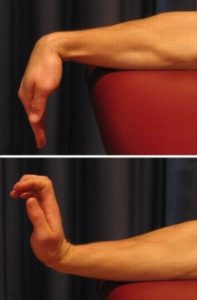
Wrist Rotations
Begin this exercise with your elbow at your side and bent to 90 degrees (figure 4). Slowly rotate your palm up and down as far as you can go without pain and provided you feel no more than a mild to moderate stretch. Repeat 10 times provided there is no increase in symptoms.

Wrist Side Bends
Begin this exercise with your forearm supported by a table or bench and your wrist and fingers over the edge (figure 5). Slowly bend your wrist from side to side as far as you can go without pain and provided you feel no more than a mild to moderate stretch. Repeat 10 times provided there is no increase in symptoms.
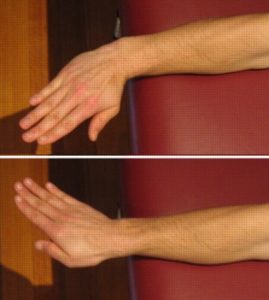
Intermediate Exercises

Members Only ContentBecome a PhysioAdvisor Member to gain full access to this exclusive content. For more details see Become a Member. Already a member? Login Now
Advanced Exercises

Members Only ContentBecome a PhysioAdvisor Member to gain full access to this exclusive content. For more details see Become a Member. Already a member? Login Now
Other Exercises

Members Only ContentBecome a PhysioAdvisor Member to gain full access to this exclusive content. For more details see Become a Member. Already a member? Login Now
Rehabilitation Protocol for wrist tendonitis

Members Only ContentBecome a PhysioAdvisor Member to gain full access to this exclusive content. For more details see Become a Member. Already a member? Login Now
 Physiotherapy products for wrist tendonitis
Physiotherapy products for wrist tendonitis
Some of the most commonly recommended products by physiotherapists to hasten healing and speed recovery in patients with this condition include:
To purchase physiotherapy products for wrist tendonitis, click on one of the above links or visit the PhysioAdvisor Shop.
 More Physiotherapy Exercises
More Physiotherapy Exercises
- Wrist Flexibility Exercises
- Wrist Strengthening Exercises
- Arm Strengthening Exercises
- Arm Stretches
- Upper Body Gym Exercises
- Cable Gym Exercises (Back & Biceps)
- Cable Gym Exercises (Chest, Shoulders & Triceps)
- Free Weight Exercises (Back & Biceps)
- Free Weight Exercises (Chest, Shoulders & Triceps)
- Massage Ball Exercises
- Foam Roller Exercises
- Pilates Exercises
 Recommended Reading
Recommended Reading
- Wrist Taping
- The R.I.C.E. Regime.
- Ice or Heat.
- Investigations
- Warming Up and Cooling Down.
- Returning to Sport.
- Posture.
- Postural Taping.
- Wrist & Hand Diagnosis Guide
 Find a Physio for wrist tendonitis
Find a Physio for wrist tendonitis
Find a Physiotherapist in your local area who can treat this condition.
Become a PhysioAdvisor Member

Link to this Page
If you would like to link to this article on your website, simply copy the code below and add it to your page:
<a href="https://physioadvisor.com.au/injuries/wrist-hand/wrist-tendonitis”>Wrist Tendonitis – PhysioAdvisor.com</a><br/>PhysioAdvisor offers detailed physiotherapy information on wrist tendonitis and wrist tendinopathy including: causes, symptoms, diagnosis, treatment, exercises, rehabilitation protocol, physiotherapy products and more...
Return to the top of Wrist Tendonitis.


